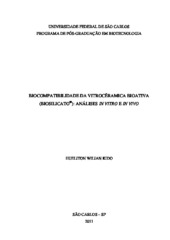Biocompatibilidade da vitrocêramica bioativa (Biosilicato®): análises in vitro e in vivo
Abstract
Due to limited availability of autogenous bone and of the risks associated with the use of bone allografts, new synthetic materials have been developed in order to replace the bone tissue lost due to trauma or pathological process. The bioactive materials in the form of scaffolds are synthetic materials promising for bone grafting. Several studies suggest that these biomaterials are able to stimulate the proliferation of osteoblasts and osteogenesis at the site of fracture. However, the feasibility of these biomaterials to a clinical application requires the investigation of their biocompatibility. In this context, this study aimed to evaluate the biocompatibility of a scaffold synthesized from a fully crystallized glass-ceramic bioactive quaternary system P2O5-Na2O-CaO-SiO2 (Biosilicate®), through histopathological analysis of the biomaterial implanted in the subcutaneous tissue of rats and the cytotoxicity and genotoxicity analysis of the biomaterial in cell cultures (OSTEO-1 and L929 cells). Histopathologic analysis of the biomaterial was performed using 65 Wistar rats male (210- 260 g), randomly divided into two groups, Control group (n = 3 animals per period) and Biosilicate group (n = 10 animals per period), evaluated at 7, 15, 30, 45 and 60 days after surgery. The animals of Biosilicate group underwent surgery and received a subcutaneous implant of Biosilicate® scaffolds. The animals of Control group underwent surgery but did not receive any biomaterial implant. The cytotoxicity analysis was performed to assess the effect of products leaching from Biosilicate® scaffolds (extracts) on cellular proliferation (MTT). The extracts were evaluated in various concentrations (100, 50, 25 and 12.5%) in experimental periods of 24, 72 and 120 hours in two cell lines (OSTEO-1 and L929). The genotoxicity analysis (comet assay) was performed to assess DNA damage in cells OSTEO-1 and L929 grown in contact with the Biosilicate® scaffolds in different periods of 24, 72 and 96 horas. The statistical analysis of parametrics data was performed by analysis of variance (ANOVA) followed by Tukey post-hoc and the analysis of nonparametrics data was performed by Mann-Whitney test. Both statistical tests were performed with a significance level of 5%. The results of histopathological analysis showed that the animals of the Control group did not present inflammation process, necrotic tissue and fibrous tissue. The animals of Biosilicato group showed a granulation tissue after 7 days of implantation. In the other periods (15, 30, 45 and 60 days) a chronic inflammation process of foreign body, marked by the presence of fibrous tissue and giant cells was observed. No infection or necrotic tissue was observed in any animal. In the analysis of cytotoxicity, it was observed that extracts of Biosilicato® scaffolds did not have any significant effect in reducing cell proliferation OSTEO-1 and L929, and that lower concentrations of the extracts (12.5 and 25%) stimulated the proliferation of both cells in periods of 72 and 120 hours. The analysis of genotoxicity showed that the Biosilicate® scaffolds did not induce DNA damage in the cell lines tested in all experimental periods. The results of this study showed that the Biosilicate® scaffolds presented biocompatibility in vivo and in vitro.
